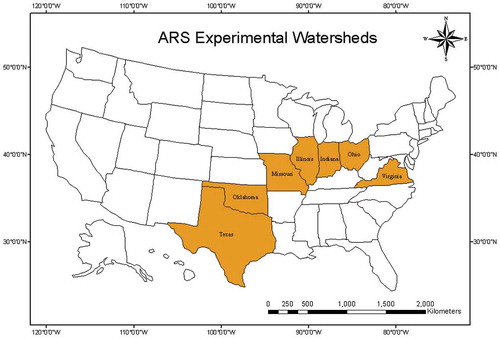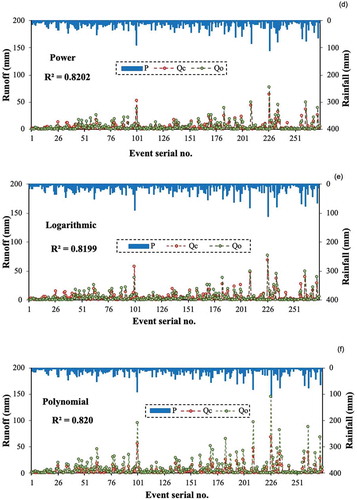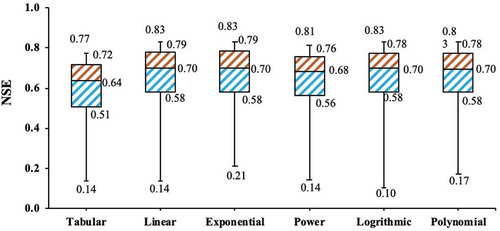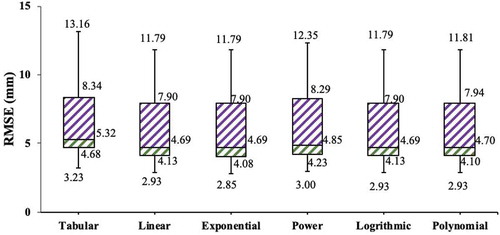 ?Mathematical formulae have been encoded as MathML and are displayed in this HTML version using MathJax in order to improve their display. Uncheck the box to turn MathJax off. This feature requires Javascript. Click on a formula to zoom.
?Mathematical formulae have been encoded as MathML and are displayed in this HTML version using MathJax in order to improve their display. Uncheck the box to turn MathJax off. This feature requires Javascript. Click on a formula to zoom.ABSTRACT
This study presents a procedure to determine improved curve numbers (CNImp) for application of the enhanced Soil Conservation Service - Curve Number (SCS-CN) model developed by Verma et al. for improved runoff prediction. To this end, five different mathematical relationships, i.e. linear, exponential, power, logarithmic and polynomial, are developed for 57 US Department of Agriculture – Agricultural Research Service (USDA-ARS) watersheds to compute CNImp with the aid of CN derivable from the National Engineering Handbook, Section-4 (NEH-4) table (CNT) and from the enhanced SCS-CN model (CNV) with significant R2 values. Using these relationships, CNImp values are computed for another 57 watersheds for validation. Based on common performance criteria, all five developed relationships for CNImp are found to be superior to the original model in runoff computation. When compared, CNImp are close to CNV and very different from CNT. Despite the fact all the relationships performed equally well, with similar performance statistics, the exponential relationship performed the best of all and the power relationship was the worst.
Editor A. Castellarin Associate editor N. Malamos
1 Introduction
The Soil Conservation Service – Curve Number (SCS-CN) technique is extensively used for assessment of runoff generation from rainfall events across the globe (Wang et al. Citation2012, Soulis Citation2018, Caletka et al. Citation2020, Verma et al. Citation2020). Its popularity around the globe is a compliment to Victor Mockus, who conceived the idea and demonstrated its applicability to field data. Due to the availability of a wide set of data linking its parameters to land uses and soil classes, the SCS developed the CN method in 1954 to design flood control projects built on agricultural watersheds (Rallison and Miller Citation1982) having a variety of combinations of land uses and soil classes, and subsequently, its application was extended to estimate runoff from urban areas (SCS Citation1975). The method has thus been used for runoff estimation around the globe for a variety of land uses and soils since its inception (Pandit and Gopalakrishnan Citation1996, Huang et al. Citation2006, Tedela et al. Citation2012, Banasik et al. Citation2014, Rutkowska et al. Citation2015, Lee et al. Citation2019). Several researchers have reported inaccuracies involved in runoff estimations from other land uses (Hawkins Citation1993, Ponce and Hawkins Citation1996, Hawkins et al. Citation2002, Schneider and McCuen Citation2005, McCutcheon et al. Citation2006, Tedela et al. Citation2012).
The key parameter of this procedure unambiguously lumps the effects of watershed parameters and climatic factors into a single coefficient known as CN (Mishra et al. Citation2006, Singh et al. Citation2010, Verma et al. Citation2017a, Citation2017b). CN is inversely linked with the retention capacity (S) of a watershed. A high CN represents low retention capacity and, hence, high runoff potential of the watershed, and vice versa (Singh et al. Citation2010, Ajmal et al. Citation2015). The actual retention, however, varies for different storm events due to varying antecedent moisture amounts, and therefore, its effect was accounted on the basis of the 5-day antecedent precipitation amount. As a result, it led to sudden jumps in runoff estimation. Several attempts were made in the past to overcome this problem (Mishra et al. Citation2006, Sahu et al. Citation2007, Singh et al. Citation2015, Verma et al. Citation2017a). Michel et al. (2005) diagnosed the major inconsistencies associated with it and provided a thorough analytical treatment underlying a soil moisture accounting procedure, leading to the development of an enhanced SCS-CN model. Sahu et al. (Citation2007), Singh et al. (Citation2015), and Ajmal et al. (Citation2015) among many others further improved the soil moisture accounting (SMA) procedure for improved runoff prediction. A few researchers, such as Michel et al. (Citation2005), Sahu et al. (Citation2007) and Ajmal et al. (Citation2015), presented simplified single-parameter models to retain the simplicity of the original model. A critical examination reveals that these models have, however, forced the parameterization such that the natural proportionality between the runoff coefficient (C = Q/P, i.e. the ratio of rainfall, P to runoff, Q) and the degree of saturation (Sr = F/S, the ratio of cumulative infiltration, F to the potential retention, S) is violated. Recently, Verma et al. (Citation2017a) developed an enhanced version of the SCS-CN method and tested its performance on 152 US Department of Agriculture – Agricultural Research Service (USDA-ARS) watersheds. Later, Verma et al. (Citation2018) further developed a single parameter for easier field application besides simplicity. Despite improved performance, these models have yet to experience field application. In contrast, the original model with a number of limitations is still popular for field application. The main reason for its widespread use is the availability of CN values in the form of a table in the National Engineering Handbook, Section 4 (referred to herein as the NEH-4 table) (SCS, Citation1972). The altered CN values required to use these advanced models limits their field application due to the unavailability of such tables. Thus, the objectives of this study are to: (a) develop relationships between NEH-4 tabular CN values and CN values of the Verma et al. (Citation2018) model; (b) develop improved CN values for use in the Verma et al. (Citation2018) model, using the developed relationship and NEH-4 tabular CN values; and (c) evaluate the performance of the proposed relationships.
2 SCS-CN method
The SCS-CN method is derived from the water-balance relationship between rainfall (P), surface runoff (Q), preliminary loss (Ia) and cumulative infiltration (F) volumes, as follows:
and the two hypotheses of proportional equality are expressed as:
where λ is the initial abstraction coefficient and S is the retention capacity of the soil. The standard mathematical expression of runoff volume in the SCS-CN model is expressed as:
The relationship between parameters S (in mm) and CN (non-dimensional) is expressed as:
2.1 Enhanced SCS-CN model
Similar to Michel et al. (Citation2005), Verma et al. (Citation2017a) unveiled the major inconsistencies of SCS-CN based Mishra and Singh (Citation2002) model. They incorporated a more appropriate and stable soil moisture accounting procedure and developed a continuous model valid at any instant of a storm event, which is expressed as:
where p is the rainfall rate, q is the runoff rate, Sa is the threshold soil moisture for runoff generation, V is the soil moisture at any instant during a storm and V0 is the initial soil moisture.
The set of equations for runoff estimation is as follows:
If V0 ≤ Sa – P, then
If Sa – P < V0 < Sa, then
If Sa ≤ V0 ≤ Sa + S, then
To compute the initial soil moisture, V0, and the threshold soil moisture, Sa, the following equations were used:
where α and β are unknown coefficients to be determined through optimization and P5 is the 5-day antecedent rainfall.
Verma et al. (Citation2018) simplified their model by reducing it to one-parameter model, similar to the existing one, for easy field application by optimizing its parameters using a large dataset of 48,763 events derived from 152 USDA-ARS watersheds. Replacing the parameters with their mean values (α = 0.19 and β = 0.12), the simplified model can be expressed as:
If then
If then
where
Now, for runoff computation, the original model uses CN values from the NEH-4 table (CNT), whereas the Verma et al. (Citation2018) model used the optimized CN value (CNV). Using these CNT and CNV values, five different relationships for different CNs, –i.e. linear, exponential, power, logarithmic and polynomial – are proposed; these are referred to as CNLin, CNExp, CNPow, CNLog and CNPol, respectively. These CNs are referred to collectively as CNImp in the next section.
3 Materials and methods
3.1 Study watersheds and data
For this study, a set of 114 USDA-ARS watersheds varying in size from 0.2 to 12 990.5 ha are selected. These records are a collection of rainfall–runoff observations from small agricultural watersheds in the USA. The rainfall–runoff data for various years are available online.Footnote1 Out of 114 watersheds, 57 are used for developing the different relationships and remaining 57 are used for validation of these developed relationships; their locations are shown in , respectively.
3.2 Determination of improved CN (CNImp)
The improved CNs (collectively CNImp) are determined using the following five steps, and their applicability conditions are also checked.
Step 1. Generate scatter plots for CNT vs. CNV using data for all 57 US watersheds.
Step 2. Fit five different relationships (linear, exponential, power, logarithmic and polynomial) and determine R2 for each relationship (see ).
Figure 3. Scatterplots of CN derived from NEH-4 (CNT) versus CN derived from Verma et al. (CNV) for (a) linear, (b) exponential, (c) logarithmic, (d) power and (e) polynomial relationships
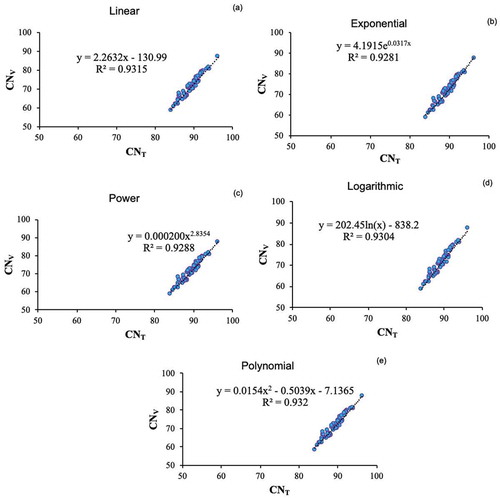
Step 3. Derive the improved CN (i.e. CNLin) for each watershed using CNT and the developed linear relationship:
Step 4. Repeat steps 1–3 to similarly derive CNExp, CNPow, CNLog and CNPol using exponential, power, logarithmic and polynomial functions, respectively, as follows:
Step 5. Calculate S using these CNs from EquationEquation (5)(5)
(5) for computing runoff using the Verma et al. (Citation2018) model. Tabular CN is also used to compute runoff using the original CN model (EquationEquation 4
(4)
(4) ). These are described in .
3.3 Applicability of the proposed CNImp
The range of CNT varies from 0 to 100 for estimating surface runoff, and so does the range of CNImp. More specifically, the proposed CNImp has its own applicability range limits. For example, CNLin varies from 0 (lower) to 95 (higher), which can be obtained if CNT ≈ 58 and CNT ≈ 100, respectively. This indicates that EquationEquation (16)(16)
(16) is valid for 58 ≤ CNT ≤ 100. Similarly, CNExp and CNPow vary from 4 to 100 and 0 to 94, respectively and can be obtained if 0 ≤ CNT ≤ 100. CNLog varies from 0 to 94, which can be obtained if 63 ≤ CNT ≤ 100, whereas CNPol varies from 0 to 96, which can be obtained if 44 ≤ CNT ≤ 100. These CNImp values are derivable from EquationEquations (16
(16)
(16) –Equation18
(18)
(18) ), respectively.
3.4 Goodness of fit
From a practical or scientific viewpoint, hydrological models are usually aimed to reproduce measurements with satisfactory precision (Seibert Citation2001). Numerous statistical methods are used to assess a model’s performance quality. For assessing model performance in terms of prediction capability, three widely accepted statistical indices – the coefficient of determination (R2), the root mean square error (RMSE), and the Nash-Sutcliffe efficiency criterion (NSE; Nash and Sutcliffe Citation1970) – are used. These are mathematically expressed as follows:
where QC is the computed runoff; QO is the observed runoff; and
are, respectively, the mean of observed and computed runoff values in a watershed; N is the total number of rainfall runoff events; and i is an integer varying from 1 to N.
4 Results and discussion
4.1 Computation of CNImp
The computed CNs using the developed relationships (EquationEquations 16(16)
(16) –Equation20
(20)
(20) ) for all 57 watersheds are listed in Appendix A, which shows that all CNImp (CNLin, CNExp, CNPow, CNLog and CNPol) are close to CNV, but far from CNT. Among all CNImp values, CNLin, CNExp, CNLog and CNPol appear very close to CNV, whereas CNPow is comparatively far from CNV.
4.2 Model comparison and performance evaluation
In this study, the computed runoff using all CNs is compared with the observed runoff. Furthermore, to assess the overall performance of the models, three goodness-of-fit measures i.e. R2, NSE and RMSE, are used (EquationEquations 21(21)
(21) –Equation23
(23)
(23) ). The R2 describes the proportion of the total variance in the observed data that can be explained by the model, and ranges from 0 to 1. Higher values of R2 show superior performance, and decreasing values indicate a poor fit. A perfect correlation is obtained if R2 = 1, and R2 = 0 indicates no fit. shows the R2 of all the models under study. For the watershed ID 44018, R2 for linear, exponential, power, logarithmic, and polynomial models is 0.8199, 0.8197, 0.8202, 0.8199, and 0.82, respectively, values that are higher than those of the tabular model (0.7588). Similar results are obtained for the other watersheds (not shown for reasons of space).
Figure 4. Coefficient of determination (R2)-based comparative performance of (a) tabular, (b) linear, (c) exponential, (d) power, (e) logarithmic and (f) polynomial models for watershed ID 44018. P: rainfall; Qc: computed runoff; Qo: observed runoff

For performance evaluation and gradation of the models, R2 was used as also recommended elsewhere (Santhi et al. Citation2001, Donigian Citation2002, Moriasi et al. Citation2012, Citation2015), and the results are shown in . According to the criterion of Santhi et al. (Citation2001) (), the proposed models (linear, exponential, power, logarithmic and polynomial) show good fit in 48, 49, 46, 48 and 48 watersheds, respectively, whereas the tabular model shows good fit in 37 watersheds only. Similarly, according to the criteria of Donigian (Citation2002) and Moriasi et al. (Citation2012) (), the performance of the linear, exponential, power, logarithmic and polynomial models was, respectively, “very good” in 13, 12, 14, 13 and 13 watersheds, “good” in 19, 20, 19, 18 and 20 watersheds and “acceptable” in 16, 17, 13, 17 and 15 watersheds. In contrast, the tabular model does not perform very good in any watersheds, while “good” and “acceptable” fit is obtained in 23 and 14 watersheds, respectively. The tabular model is unsatisfactory in 20 watersheds, whereas the proposed model performance is unsatisfactory for a comparatively smaller number of watersheds. Similar results were obtained when the models were tested according to the criteria defined by Moriasi et al. (Citation2015), further indicating the improved performance of the proposed models.
Table 1. Mathematical description of models under study. CN: curve number
Table 2. Model performance based on coefficient of determination (R2). Exp.: exponential; Log.: logarithmic; Poly.: polynomial
According to Ahmadisharaf et al. (Citation2019), the R2 criterion is unresponsive to additive and proportional differences between the simulated and observed values, but is more responsive to outliers than to the values near the mean, which could lead to a bias towards the extreme values. To overcome the limitations associated with the use of R2, an alternative measure of goodness of fit, i.e. NSE, is used. The NSE compares the variance of the errors against the observations and varies from −∞ to 1. NSE = 1 is the optimum value, indicating that the observed vs. simulated data perfectly fit the 1:1 line. Values between 0 and 1 are generally considered acceptable, but with varying levels of performance, whereas values <0 indicate unacceptable performance – i.e. the model cannot predict better than the mean observed value. The NSE values for all the models under study are listed in Appendix B. presents a box-and-whisker plot comparing the models in terms of their performance based on NSE. The mean, median, and inter-quartile range of NSE for linear, exponential, power, logarithmic, and polynomial models is higher than the tabular model statistic.
Performance is also evaluated according to the NSE grades, as shown in . According to the grading system of Santhi et al. (Citation2001), the linear, exponential, power, logarithmic, and polynomial models exhibit satisfactory performance in 55, 55, 54, 55, and 56 watersheds, respectively, whereas the tabular model shows satisfactory performance in only 43 watersheds. When the performance is judged according to the criteria of Moriasi et al. (Citation2007), the linear, exponential, power, logarithmic, polynomial and tabular models show very good performance in 23, 23, 24, 23, 23 and 5 watersheds, respectively, which indicates the improved performance of the proposed models over the tabular model. Unsatisfactory performance of the proposed models for a comparatively smaller number of watersheds also indicates their improved performance. Similar results were obtained when the models were tested according to the criteria of Moriasi et al. (Citation2015). Furthermore, according to the criteria of Ritter and Mu~noz-Carpena (Citation2013), the linear, exponential, power, logarithmic, polynomial, and tabular models showed acceptable performance in 28, 27, 27, 28, 28, and 26 watersheds, respectively, and good performance in 10, 11, 12, 10, 11, and 0 watersheds, respectively. None of the models showed very good performance in any watershed. The tabular model showed unsatisfactory performance in 31 watersheds, whereas the linear, exponential, power, logarithmic, and polynomial models showed unsatisfactory performance in 19, 19, 18, 19, and 19 watersheds, respectively, indicating the enhanced performance of all the proposed models.
Table 3. Model performance based on Nash-Sutcliffe efficiency criterion (NSE). Exp.: exponential; Log.: logarithmic; Poly.: polynomial
The RMSE provides an estimate of the error between the simulated and observed data. A higher value of RMSE indicates inferior model performance and vice versa. A perfect agreement between the observed and the computed value is obtained if RMSE = 0. The RMSE values for all the models under study are listed in Appendix B. shows the comparison of model performance on the basis of RMSE. The mean, median, and inter-quartile range of RMSE for linear, exponential, power, logarithmic, and polynomial models is lower than the RMSE statistics for the tabular model. The results thus indicate that all the proposed models (linear, exponential, power, logarithmic, and polynomial) perform equally well.
5 Conclusions
This study presented a procedure to determine improved curve numbers, CNImp (viz. CNLin, CNExp, CNPow, CNLog and CNPol) using CNT and five different mathematical relationships for estimating more accurate surface runoff. The CNImp values were found to be close to the CNV values and very different from CNT when their performance was tested on 57 USDA-ARS watersheds. The proposed models are found to be superior to the tabular model, as evidenced by higher R2 and NSE statistics and lower RMSE statistics, as well as by visual assessment. Despite the fact that all of the proposed models performed almost equally well based on R2, RMSE, and NSE statistics, the proposed models can be used for enhanced runoff prediction using the tabulated NEH-4 CN values. This underscores the efficacy of the Verma et al. (Citation2018) model in improved runoff estimation for ungauged watersheds.
Acknowledgements
The authors are thankful to the anonymous reviewers, as well as to the associate editor, Professor Nikolaos Malamos, for their encouraging comments which helped to improve the article.
Disclosure statement
No potential conflict of interest was reported by the authors.
Notes
References
- Ahmadisharaf, E., et al., 2019. Calibration and validation of watershed models and advances in uncertainty analysis in TMDL Studies. Journal of Hydrologic Engineering, 24 (7), 3119001. doi:10.1061/(ASCE)HE.1943-5584.0001794
- Ajmal, M., et al., 2015. Evolution of a parsimonious rainfall–runoff model using soil moisture proxies. Journal of Hydrology, 530, 623–633. doi:10.1016/j.jhydrol.2015.10.019
- Banasik, K., et al., 2014. Curve number estimation for small urban catchment from recorded rainfall-runoff events. Archives of Environmental Protection, 40 (4), 75–86. doi:10.2478/aep-2014-0032
- Caletka, M., et al., 2020. Improvement of SCS-CN initial abstraction coefficient in the Czech Republic: a study of five catchments. Water, 12 (7), 1964. doi:10.3390/w12071964
- Donigian, A., 2002. Watershed model calibration and validation: the HSPF experience. Proceedings of the Water Environment Federation, 8 (8), 44–73. doi:10.2175/193864702785071796
- Hawkins, R.H., 1993. Asymptotic determination of runoff curve numbers from data. Journal of Irrigation and Drainage Engineering, ASCE, 119 (2), 334–345. doi:10.1061/(ASCE)0733-9437(1993)119:2(334)
- Hawkins, R.H., et al., 2002. Runoff curve number method: examination of the initial abstraction ratio. Proceedings of the Second Federal Interagency Hydrologic Modeling Conference. ASCE, Las Vegas, NV.
- Huang, M., et al., 2006. A modification to the soil conservation service curve number method for steep slopes in the Loess plateau of China. Hydrological Processes, 20 (3), 579–589. doi:10.1002/hyp.5925
- Lee, J.-Y., et al., 2019. Feasible ranges of runoff curve numbers for Korean watersheds based on the interior point optimization algorithm. KSCE Journal of Civil Engineering, 23 (12), 5257–5265. doi:10.1007/s12205-019-0901-9
- McCutcheon, S.C., 2006. Rainfall-runoff relationships for selected eastern U.S. forested mountain watersheds: testing of the curve number method for flood analysis. Technical Report, West Virginia Division of Forestry, Charleston, WV.
- Michel, C., Vazken, A., and Charles, P., 2005. Soil conservation service curve number method: how to mend among soil moisture accounting procedure? Water Resources Research, 41 (2), 1–6. doi:10.1029/2004WR003191
- Mishra, S.K., et al., 2006. An improved Ia-S relation incorporating antecedent moisture in SCS-CN methodology. Water Resources Management, 20 (5), 643–660. doi:10.1007/s11269-005-9000-4
- Mishra, S.K. and Singh, V.P., 2002. SCS-CN method: part I: derivation of SCS-CN based models. Acta Geophysica Polonica, 50 (3), 457–477.
- Moriasi, D.N., et al., 2007. Model evaluation guidelines for systematic quantification of accuracy in watershed simulations. Transactions of the American Society of Agricultural and Biological Engineers, 50, 885–900.
- Moriasi, D.N., et al., 2012. Hydrologic and water quality models: use, calibration, and validation. Transactions of the American Society of Agricultural and Biological Engineers, 55 (4), 1241–1247.
- Moriasi, D.N., et al., 2015. Hydrologic and water quality models: performance measures and evaluation criteria. Transactions of the American Society of Agricultural and Biological Engineers, 58 (6), 1763–1785.
- Nash, J.E. and Sutcliffe, J.V., 1970. River flow forecasting through conceptual models: part I- A discussion of principles. Journal of Hydrology, 10 (3), 282–290. doi:10.1016/0022-1694(70)90255-6
- Pandit, A. and Gopalakrishnan, G., 1996. Estimation of annual storm runoff coefficients by continuous simulation. Journal of Irrigation and Drainage Engineering, ASCE, 122 (4), 211–220. doi:10.1061/(ASCE)0733-9437(1996)122:4(211)
- Ponce, V.M. and Hawkins, R.H., 1996. Runoff curve number: has it reached maturity? Journal of Hydraulic Engineering, ASCE, 1 (1), 11–19. doi:10.1061/(ASCE)1084-0699(1996)1:1(11)
- Rallison, R.E. and Miller, N., 1982. Past, present and future SCS runoff procedure. Proceedings of international symposium on rainfall-runoff modeling. Littleton, Colordo: Water Resources Publications, 353–364.
- Ritter, A. and Mu~noz-Carpena, R., 2013. Performance evaluation of hydrological models: statistical significance for reducing subjectivity in goodness-of-fit assessments. Journal of Hydrology, 480, 33–45. doi:10.1016/j.jhydrol.2012.12.004
- Rutkowska, A., et al., 2015. Probabilistic properties of a curve number: A case study for small Polish and Slovak Carpathian Basins. Journal of Mountain Science, 12 (3), 533–548.
- Sahu, R.K., et al., 2007. An advanced soil moisture accounting procedure for SCS curve number method. Hydrological Processes, 21 (21), 2827–2881. doi:10.1002/hyp.6503
- Santhi, C., et al., 2001. Validation of the swat model on a large RWER basin with point and nonpoint sources. Journal of the American Water Resources Association, 37 (5), 1169–1188. doi:10.1111/j.1752-1688.2001.tb03630.x
- Schneider, L.E. and McCuen, R.H., 2005. Statistical guideline for curve number generation. Journal of Irrigation and Drainage Engineering, 131 (3), 282–290. doi:10.1061/(ASCE)0733-9437(2005)131:3(282)
- SCS (Soil Conservation Service), 1972. National engineering handbook. Supplement A, Section 4, Chapter 10. Washington, DC: Soil Conservation Service, US Department of Agriculture.
- SCS (Soil Conservation Service), 1975. Urban hydrology for small watersheds. Technical Release 55. Washington, DC: U.S. Department of Agriculture.
- Seibert, J., 2001. On the need for benchmarks in hydrological modelling. Hydrological Processes, 15 (6), 1063–1064. doi:10.1002/hyp.446
- Singh, P.K., et al., 2010. An updated hydrological review on recent advancements in soil conservation service curve-number technique. Journal of Water and Climate Change, 1 (2), 118–134. doi:10.2166/wcc.2010.022
- Singh, P.K., et al., 2015. Development of a modified SMA based MSCS-CN model for runoff estimation. Water Resources Management, 29 (11), 4111–4127.
- Soulis, K.X., 2018. Estimation of SCS curve number variation following forest fires. Hydrological Sciences Journal, 63 (9), 1332–1346. doi:10.1080/02626667.2018.1501482
- Tedela, N.H., et al., 2012. Runoff curve numbers for 10 small forested watersheds in the mountains of the Eastern United States. Journal of Hydrologic Engineering, 17 (11), 1188–1198. doi:10.1061/(ASCE)HE.1943-5584.0000436
- Verma, S., et al., 2017a. An enhanced SMA based SCS-CN inspired model for watershed runoff prediction. Environmental Earth Sciences, 76 (21), 736. doi:10.1007/s12665-017-7062-2
- Verma, S., et al., 2017b. A revisit of NRCS-CN methodology and application of RS and GIS for surface runoff estimation. Hydrological Sciences Journal, 62 (12), 1891–1930. doi:10.1080/02626667.2017.1334166
- Verma, S., et al., 2018. Simplified SMA-inspired 1-parameter SCS-CN model for runoff estimation. Arabian Journal of Geosciences, 11 (15), 420. doi:10.1007/s12517-018-3736-7
- Verma, S., et al., 2020. Activation Soil Moisture Accounting (ASMA) for runoff estimation using Soil Conservation Service Curve Number (SCS-CN) method. Journal of Hydrology, 589, 125114. doi:10.1016/j.jhydrol.2020.125114
- Wang, X., Liu, T., and Yang, W., 2012. Development of a robust runoff-prediction model by fusing the Rational Equation and a modified SCS-CN method. Hydrological Sciences Journal, 57 (6), 1118–1140. doi:10.1080/02626667.2012.701305
Appendix A
Curve numbers (CN) obtained using the developed relationships. WS: watershed.
Appendix B
Root mean square error (RMSE) and Nash-Sutcliffe efficiency criterion (NSE) of all the models under study. WS: watershed.

